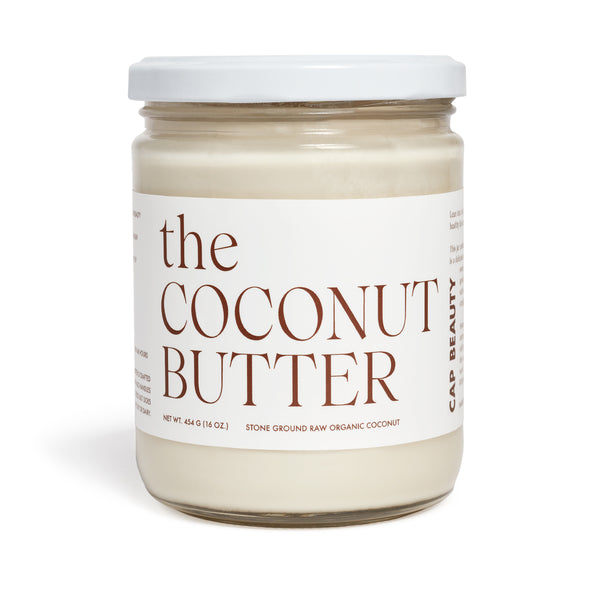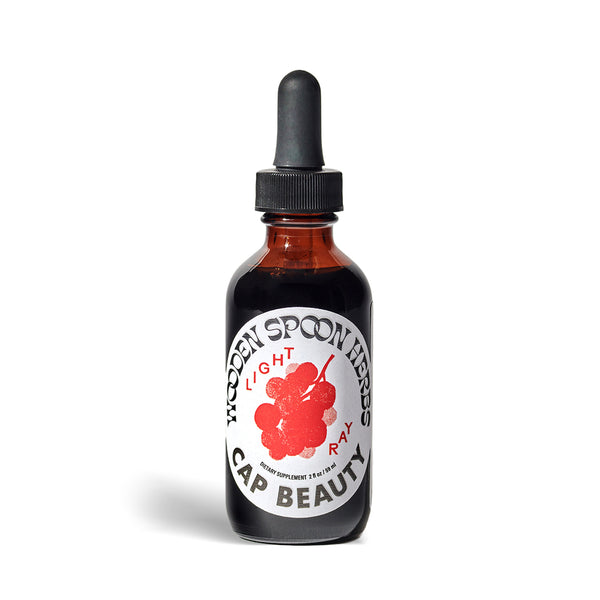The Light Ray brief was to create a delicious tincture that relied on the power of plants to encourage healthy and vibrant skin. How did you come up with the formulation that you thought would be the best way to achieve that?
When I started thinking about what to prioritize for healthy skin, it was a very obvious few things: antioxidants, vitamin C, liver support, hydrating herbs and B vitamins. I was thinking, "If I were trying to eat for glowing skin, what would I be eating?" And berries and greens were the obvious answer. So then I was like, ok, how do we get that in a bottle, without it being a fresh pressed juice? So the nettle, goji berry, rosehip, schisandra and hibiscus really came into play there. Vitamin C is a key cofactor for collagen production that goji, rosehip, schisandra. and hibiscus are unbelievably high in. Schisandra berries are also adaptogenic, and stress is one of the first things to make our skin stressed, in addition to being super supportive for the liver. Giving our body the nutrients it needs and supporting the other major organs of elimination (kidney, colon, liver) are great places to start for skin health and glow.
I don't drink alcohol and try my best to stay away from alcohol based tinctures (although there are some I still take!), so glycerine was a natural choice as the delivery system for TLR. I love the way this feels in the mouth; a juicier and non-astringent remedy that feels full and loving. Can you explain a bit about the difference in these two mediums, and why you felt glycerine was appropriate here?
I really love glycerine as well, and I think that while alcohol has merit for shelf stability and tradition as far as herbal medicine is concerned, glycerine is just a lesser-used medium for extracting phytochemicals. While it's sugar-free, it tastes sweet. It's processed like alcohol in the body, but the dosage of a tincture is only as alcoholic as a bit of very ripe fruit. I think anytime we can make our herbs taste amazing, people are more inclined to take them regularly. The Light Ray tastes like jam, like dessert.
How do you source your glycerine and what is it made from?
We work with our manufacturer on all of our sourcing, paying very close attention to where every ingredient comes from. Our vegetable glycerine is NOT palm-derived, as most are. It's actually derived from flax seed, which I love. Sometimes we also use a coconut-derived glycerine.
Please share the ingredients you used in TLR and let us know why these particular plants came together in your formulation? Also, do these particular plants work well together, is it a bit like an orchestra in that manner?
Herbs in formula do have a synergy, a "chemistry" beyond just the co-mingling of phytochemicals. It can be shown in a lab - blends steeped together show higher concentrations of phytochemical markers than single herb tinctures made separately and then blended. Which is wild, but intuitively I've always believed that. (Gotta love when science validates intuition.)
So when I'm blending, I do always tap into my direct relationship with the plants I'm working with, and try to feel into "who likes whom," or what blend just feels right together. That was definitely the case with The Light Ray.
The Light Ray is a blend of:
Nettle: high in B vitamins, including biotin, as well as a host of other vitamins and minerals (and protein when eaten as a vegetable)
Gotu Kola: super hydrating for the skin, helps with skin elasticity
Hibiscus: loaded with antioxidants and vitamin C
Goji berry: adaptogenic berry that hydrates and lends vitamin C and lycopene
Rosehips: deeply nourishing and hydrating, this dewy fruit of the rose flower has lots of vitamin C to share
Schisandra: adaptogenic berry with all five flavors, supports the liver, high in vitamin C
How many iterations did you go through before landing on the perfection of TLR?
Honestly, the first batch was the home run.
It's so important to have tinctures be easy and enjoyable to take, as they work best when we are consistent in taking them. Do you have any tricks, beyond making them delicious , to encourage more consistency when taking herbs?
1. Keeping them in plain sight. I keep them right in my cupboard, so I'm always reminded to take my supplements when I'm making my morning tea.
2. Develop a routine, take them at the same time each day.
3. Take them with you! If you are traveling or just running errands, put them in your bag for a little pick-me-up, or to have them when you need them.




